Gaussian Process Modeling of In-Season Physiological Parameters of Spring Wheat Based on Airborne Imagery from Two Hyperspectral Cameras and Apparent Soil Electrical Conductivity
Abstract
1. Introduction
2. Materials and Methods
2.1. Experimental Site
2.2. Hyperspectral Data Acquisition and Pre-Processing
2.3. Ground Data Collection
2.4. Data Analysis
2.5. Reproducing the Study
3. Results
3.1. Effects of Data Transformations
3.2. Dry Matter
3.3. Nitrogen Content
3.4. Nitrogen Uptake
3.5. Evidence of Training Data Overfitting with the ESAM Kernel
3.6. Mapping of Crop Parameter Predictions
3.7. Post Hoc Analyses
4. Discussion
4.1. Performance of the Models
4.2. The Influence of Training Data Sources
4.3. Prediction Map Patterns
5. Conclusions
Supplementary Materials
Author Contributions
Funding
Institutional Review Board Statement
Informed Consent Statement
Data Availability Statement
Acknowledgments
Conflicts of Interest
References
- Späti, K.; Huber, R.; Finger, R. Benefits of Increasing Information Accuracy in Variable Rate Technologies. Ecol. Econ. 2021, 185, 107047. [Google Scholar] [CrossRef]
- Poudel, P.B.; Poudel, M.R.; Gautam, A.; Phuyal, S.; Tiwari, C.K.; Bashyal, N.; Bashyal, S. COVID-19 and its Global Impact on Food and Agriculture. J. Biol. Today’s World 2020, 9, 221. [Google Scholar]
- Colussi, J.; Schnitkey, G.; Zulauf, C. War in Ukraine and its Effect on Fertilizer Exports to Brazil and the U.S. Farmdoc Dly. 2022, 12, 1–5. [Google Scholar]
- Lemaire, G.; Jeuffroy, M.H.; Gastal, F. Diagnosis tool for plant and crop N status in vegetative stage: Theory and practices for crop N management. Eur. J. Agron. 2008, 28, 614–624. [Google Scholar] [CrossRef]
- Berger, K.; Verrelst, J.; Féret, J.B.; Hank, T.; Wocher, M.; Mauser, W.; Camps-Valls, G. Retrieval of aboveground crop nitrogen content with a hybrid machine learning method. Int. J. Appl. Earth Obs. Geoinf. 2020, 92, 102174. [Google Scholar] [CrossRef]
- Söderström, M.; Piikki, K.; Stenberg, M.; Stadig, H.; Martinsson, J. Producing nitrogen (N) uptake maps in winter wheat by combining proximal crop measurements with Sentinel-2 and DMC satellite images in a decision support system for farmers. Acta Agric. Scand. Sect. B—Soil Plant Sci. 2017, 67, 637–650. [Google Scholar] [CrossRef]
- Argento, F.; Anken, T.; Abt, F.; Vogelsanger, E.; Walter, A.; Liebisch, F. Site-specific nitrogen management in winter wheat supported by low-altitude remote sensing and soil data. Precis. Agric. 2021, 22, 364–386. [Google Scholar] [CrossRef]
- Stoorvogel, J.J.; Kooistra, L.; Bouma, J. Managing Soil Variability at Different Spatial Scales as a Basis for Precision Agriculture. In Soil-Specific Farming: Precision Agriculture; Advances in Soil Science; Lal, R., Stewart, B., Eds.; CRC Press: Boca Raton, FL, USA, 2015; Volume 22, pp. 37–71. [Google Scholar]
- Wójtowicz, M.; Wójtowicz, A.; Piekarczyk, J. Application of remote sensing methods in agriculture. Commun. Biometry Crop. Sci. 2016, 11, 31–50. [Google Scholar]
- Banerjee, B.P.; Sharma, V.; Spangenberg, G.; Kant, S. Machine Learning Regression Analysis for Estimation of Crop Emergence Using Multispectral UAV Imagery. Remote Sens. 2021, 13, 2918. [Google Scholar] [CrossRef]
- Nex, F.; Armenakis, C.; Cramer, M.; Cucci, D.A.; Gerke, M.; Honkavaara, E.; Kukko, A.; Persello, C.; Skaloud, J. UAV in the advent of the twenties: Where we stand and what is next. ISPRS J. Photogramm. Remote Sens. 2022, 184, 215–242. [Google Scholar] [CrossRef]
- Gewali, U.B.; Monteiro, S.T.; Saber, E. Gaussian Processes for Vegetation Parameter Estimation from Hyperspectral Data with Limited Ground Truth. Remote Sens. 2019, 11, 1614. [Google Scholar] [CrossRef]
- Fu, Y.; Yang, G.; Pu, R.; Li, Z.; Li, H.; Xu, X.; Song, X.; Yang, X.; Zhao, C. An overview of crop nitrogen status assessment using hyperspectral remote sensing: Current status and perspectives. Eur. J. Agron. 2021, 124, 126241. [Google Scholar] [CrossRef]
- Zhou, K.; Cheng, T.; Zhu, Y.; Cao, W.; Ustin, S.L.; Zheng, H.; Yao, X.; Tian, Y. Assessing the Impact of Spatial Resolution on the Estimation of Leaf Nitrogen Concentration Over the Full Season of Paddy Rice Using Near-Surface Imaging Spectroscopy Data. Front. Plant Sci. 2018, 9, 964. [Google Scholar] [CrossRef] [PubMed]
- Bruning, B.; Liu, H.; Brien, C.; Berger, B.; Lewis, M.; Garnett, T. The Development of Hyperspectral Distribution Maps to Predict the Content and Distribution of Nitrogen and Water in Wheat (Triticum aestivum). Front. Plant Sci. 2019, 10. [Google Scholar] [CrossRef]
- Mao, H.; Meng, J.; Ji, F.; Zhang, Q.; Fang, H. Comparison of Machine Learning Regression Algorithms for Cotton Leaf Area Index Retrieval Using Sentinel-2 Spectral Bands. Appl. Sci. 2019, 9, 1459. [Google Scholar] [CrossRef]
- Kganyago, M.; Mhangara, P.; Adjorlolo, C. Estimating Crop Biophysical Parameters Using Machine Learning Algorithms and Sentinel-2 Imagery. Remote Sens. 2021, 13, 4314. [Google Scholar] [CrossRef]
- Rosso, P.; Nendel, C.; Gilardi, N.; Udroiu, C.; Chlebowski, F. Processing of remote sensing information to retrieve leaf area index in barley: A comparison of methods. Precis. Agric. 2022, 23, 1449–1472. [Google Scholar] [CrossRef]
- Zhang, J.; Cheng, T.; Shi, L.; Wang, W.; Niu, Z.; Guo, W.; Ma, X. Combining spectral and texture features of UAV hyperspectral images for leaf nitrogen content monitoring in winter wheat. Int. J. Remote Sens. 2022, 43, 2335–2356. [Google Scholar] [CrossRef]
- Verrelst, J.; Malenovský, Z.; Van der Tol, C.; Camps-Valls, G.; Gastellu-Etchegorry, J.P.; Lewis, P.; North, P.; Moreno, J. Quantifying Vegetation Biophysical Variables from Imaging Spectroscopy Data: A Review on Retrieval Methods. Surv. Geophys. 2019, 40, 589–629. [Google Scholar] [CrossRef]
- Martens, H. Reliable and relevant modelling of real world data: A personal account of the development of PLS Regression. Chemom. Intell. Lab. Syst. 2001, 58, 85–95. [Google Scholar] [CrossRef]
- Thissen, U.; Pepers, M.; Üstün, B.; Melssen, W.; Buydens, L. Comparing support vector machines to PLS for spectral regression applications. Chemom. Intell. Lab. Syst. 2004, 73, 169–179. [Google Scholar] [CrossRef]
- Ziegler, A.; König, I.R. Mining data with random forests: Current options for real-world applications. Wiley Interdiscip. Rev. Data Min. Knowl. Discov. 2014, 4, 55–63. [Google Scholar] [CrossRef]
- Camps-Valls, G.; Verrelst, J.; Munoz-Mari, J.; Laparra, V.; Mateo-Jiménez, F.; Gómez-Dans, J. A survey on Gaussian processes for earth-observation data analysis: A comprehensive investigation. IEEE Geosci. Remote Sens. Mag. 2016, 4, 58–78. [Google Scholar] [CrossRef]
- Rasmussen, C.E. Gaussian Processes in Machine Learning. In Advanced Lectures on Machine Learning; Lecture Notes in Computer Science; Bousquet, O., von Luxburg, U., Rätsch, G., Eds.; Springer: Berlin/Heidelberg, Germany, 2004; Volume 3176, pp. 63–71. [Google Scholar] [CrossRef]
- Schulz, E.; Speekenbrink, M.; Krause, A. A tutorial on Gaussian process regression: Modelling, exploring, and exploiting functions. J. Math. Psychol. 2018, 85, 1–16. [Google Scholar] [CrossRef]
- Verrelst, J.; Alonso, L.; Camps-Valls, G.; Delegido, J.; Moreno, J. Retrieval of Vegetation Biophysical Parameters Using Gaussian Process Techniques. IEEE Trans. Geosci. Remote Sens. 2012, 50, 1832–1843. [Google Scholar] [CrossRef]
- Verrelst, J.; Rivera, J.P.; Gitelson, A.; Delegido, J.; Moreno, J.; Camps-Valls, G. Spectral band selection for vegetation properties retrieval using Gaussian processes regression. Int. J. Appl. Earth Obs. Geoinf. 2016, 52, 554–567. [Google Scholar] [CrossRef]
- Estévez, J.; Berger, K.; Vicent, J.; Rivera-Caicedo, J.P.; Wocher, M.; Verrelst, J. Top-of-Atmosphere Retrieval of Multiple Crop Traits Using Variational Heteroscedastic Gaussian Processes within a Hybrid Workflow. Remote Sens. 2021, 13, 1589. [Google Scholar] [CrossRef]
- Fu, Y.; Yang, G.; Li, Z.; Song, X.; Li, Z.; Xu, X.; Wang, P.; Zhao, C. Winter Wheat Nitrogen Status Estimation Using UAV-based RGB Imagery and Gaussian Processes Regression. Remote Sens. 2020, 12, 3778. [Google Scholar] [CrossRef]
- Abebe, G.; Tadesse, T.; Gessesse, B. Estimating Leaf Area Index and biomass of sugarcane based on Gaussian process regression using Landsat 8 and Sentinel 1A observations. Int. J. Image Data Fusion 2022, 1–31. [Google Scholar] [CrossRef]
- Verrelst, J.; Muñoz, J.; Alonso, L.; Delegido, J.; Rivera, J.P.; Camps-Valls, G.; Moreno, J. Machine learning regression algorithms for biophysical parameter retrieval: Opportunities for Sentinel-2 and -3. Remote Sens. Environ. 2012, 118, 127–139. [Google Scholar] [CrossRef]
- Wen, D.; Tongyu, X.; Fenghua, Y.; Chunling, C. Measurement of nitrogen content in rice by inversion of hyperspectral reflectance data from an unmanned aerial vehicle. Ciência Rural 2018, 48, e20180008. [Google Scholar] [CrossRef]
- Verrelst, J.; Berger, K.; Rivera-Caicedo, J.P. Intelligent Sampling for Vegetation Nitrogen Mapping Based on Hybrid Machine Learning Algorithms. IEEE Geosci. Remote Sens. Lett. 2020, 18, 2038–2042. [Google Scholar] [CrossRef] [PubMed]
- Gewali, U.B.; Monteiro, S.T. A novel covariance function for predicting vegetation biochemistry from hyperspectral imagery with Gaussian processes. In Proceedings of the 2016 IEEE International Conference on Image Processing (ICIP), Phoenix, AZ, USA, 25–28 September 2016; pp. 2216–2220. [Google Scholar] [CrossRef]
- Gewali, U.B.; Monteiro, S.T. Spectral angle based unary energy functions for spatial-spectral hyperspectral classification using Markov random fields. In Proceedings of the 2016 8th Workshop on Hyperspectral Image and Signal Processing: Evolution in Remote Sensing (WHISPERS), Los Angeles, CA, USA, 21–24 August 2016; pp. 1–6. [Google Scholar] [CrossRef]
- Gewali, U.B.; Monteiro, S.T. A tutorial on modelling and inference in undirected graphical models for hyperspectral image analysis. Int. J. Remote Sens. 2018, 39, 7104–7143. [Google Scholar] [CrossRef]
- Heiß, A.; Paraforos, D.S.; Sharipov, G.M.; Griepentrog, H.W. Real-time control for multi-parametric data fusion and dynamic offset optimization in sensor-based variable rate nitrogen application. Comput. Electron. Agric. 2022, 196, 106893. [Google Scholar] [CrossRef]
- Crema, A.; Boschetti, M.; Nutini, F.; Cillis, D.; Casa, R. Influence of Soil Properties on Maize and Wheat Nitrogen Status Assessment from Sentinel-2 data. Remote Sens. 2020, 12, 2175. [Google Scholar] [CrossRef]
- Wang, W.; Zheng, H.; Wu, Y.; Yao, X.; Zhu, Y.; Cao, W.; Cheng, T. An assessment of background removal approaches for improved estimation of rice leaf nitrogen concentration with unmanned aerial vehicle multispectral imagery at various observation times. Field Crop. Res. 2022, 283, 108543. [Google Scholar] [CrossRef]
- Hu, P.; Guo, W.; Chapman, S.C.; Guo, Y.; Zheng, B. Pixel size of aerial imagery constrains the applications of unmanned aerial vehicle in crop breeding. ISPRS J. Photogramm. Remote Sens. 2019, 154, 1–9. [Google Scholar] [CrossRef]
- Zhang, J.; Wang, C.; Yang, C.; Xie, T.; Jiang, Z.; Hu, T.; Luo, Z.; Zhou, G.; Xie, J. Assessing the Effect of Real Spatial Resolution of In Situ UAV Multispectral Images on Seedling Rapeseed Growth Monitoring. Remote Sens. 2020, 12, 1207. [Google Scholar] [CrossRef]
- Jay, S.; Gorretta, N.; Morel, J.; Maupas, F.; Bendoula, R.; Rabatel, G.; Dutartre, D.; Comar, A.; Baret, F. Estimating leaf chlorophyll content in sugar beet canopies using millimeter-to centimeter-scale reflectance imagery. Remote Sens. Environ. 2017, 198, 173–186. [Google Scholar] [CrossRef]
- Heiß, A.; Paraforos, D.S.; Sharipov, G.M.; Griepentrog, H.W. Modeling and simulation of a multi-parametric fuzzy expert system for variable rate nitrogen application. Comput. Electron. Agric. 2021, 182, 106008. [Google Scholar] [CrossRef]
- Mouazen, A.; Alhwaimel, S.; Kuang, B.; Waine, T. Fusion of data from multiple soil sensors for the delineation of water holding capacity zones. In Precision Agriculture’13; Stafford, J.V., Ed.; Wageningen Academic Publishers: Lleida, Spain, 2013; pp. 745–751. [Google Scholar]
- Ji, W.; Adamchuk, V.I.; Chen, S.; Su, A.S.M.; Ismail, A.; Gan, Q.; Shi, Z.; Biswas, A. Simultaneous measurement of multiple soil properties through proximal sensor data fusion: A case study. Geoderma 2019, 341, 111–128. [Google Scholar] [CrossRef]
- Franke, J.; Menz, G. Multi-temporal wheat disease detection by multi-spectral remote sensing. Precis. Agric. 2007, 8, 161–172. [Google Scholar] [CrossRef]
- Meier, U. (Ed.) Growth Stages of Mono- and Dicotyledoneous Plants. BBCH Monograph; Federal Biological Research Centre for Agriculture and Forestry: Berlin/Braunschweig, Germany, 2001; p. 158. [Google Scholar]
- Geipel, J.; Bakken, A.K.; Jørgensen, M.; Korsaeth, A. Forage yield and quality estimation by means of UAV and hyperspectral imaging. Precis. Agric. 2021, 22, 1437–1463. [Google Scholar] [CrossRef]
- Koirala, P.; Løke, T.; Baarstad, I.; Fridman, A.; Hernandez, J. Real-time hyperspectral image processing for UAV applications, using HySpex Mjolnir-1024. In Algorithms and Technologies for Multispectral, Hyperspectral, and Ultraspectral Imagery XXIII; Velez-Reyes, M., Messinger, D.W., Eds.; International Society for Optics and Photonics, SPIE: Anaheim, CA, USA, 2017; Volume 10198, p. 1019807. [Google Scholar] [CrossRef]
- Rouse, J.; Hass, R.; Schell, J.; Deering, D. Monitoring vegetation systems in the Great Plains with ERTS. In Third Earth Resources Technology Satellite-1 Symposium; Freden, S.C., Mercanti, E.P., Becker, M.A., Eds.; Goddart Space Flight Center: Washington, DC, USA, 1973; Volume 1, pp. 309–317. [Google Scholar]
- Fystro, G.; Lunnan, T. Analysar av grovfôrkvalitet på NIRS. In Plantemøtet Østlandet 2006; Bioforsk FOKUS; Kristoffersen, A.Ø, Ed.; Bioforsk Øst Apelsvoll: Tønsberg, Norway, 2006; Volume 1, pp. 180–181. [Google Scholar]
- Jones, D.B. Factors for Converting Percentages of Nitrogen in Foods and Feeds into Percentages of Proteins; US Department of Agriculture Circular: Washington, DC, USA, 1941; pp. 1–22.
- Muñoz-Huerta, R.F.; Guevara-Gonzalez, R.G.; Contreras-Medina, L.M.; Torres-Pacheco, I.; Prado-Olivarez, J.; Ocampo-Velazquez, R.V. A Review of Methods for Sensing the Nitrogen Status in Plants: Advantages, Disadvantages and Recent Advances. Sensors 2013, 13, 10823–10843. [Google Scholar] [CrossRef]
- Guo, B.B.; Qi, S.L.; Heng, Y.R.; Duan, J.Z.; Zhang, H.Y.; Wu, Y.P.; Feng, W.; Xie, Y.X.; Zhu, Y.J. Remotely assessing leaf N uptake in winter wheat based on canopy hyperspectral red-edge absorption. Eur. J. Agron. 2017, 82, 113–124. [Google Scholar] [CrossRef]
- Adamchuk, V.I.; Hummel, J.W.; Morgan, M.T.; Upadhyaya, S.K. On-the-go soil sensors for precision agriculture. Comput. Electron. Agric. 2004, 44, 71–91. [Google Scholar] [CrossRef]
- Kennard, R.W.; Stone, L.A. Computer Aided Design of Experiments. Technometrics 1969, 11, 137–148. [Google Scholar] [CrossRef]
- Bonfil, D.J.; Michael, Y.; Shiff, S.; Lensky, I.M. Optimizing Top Dressing Nitrogen Fertilization Using VENμS and Sentinel-2 L1 Data. Remote Sens. 2021, 13, 3934. [Google Scholar] [CrossRef]
- Kusnierek, K.; Korsaeth, A. Simultaneous identification of spring wheat nitrogen and water status using visible and near infrared spectra and Powered Partial Least Squares Regression. Comput. Electron. Agric. 2015, 117, 200–213. [Google Scholar] [CrossRef]
- Song, X.; Xu, D.; Huang, C.; Zhang, K.; Huang, S.; Guo, D.; Zhang, S.; Yue, K.; Guo, T.; Wang, S.; et al. Monitoring of nitrogen accumulation in wheat plants based on hyperspectral data. Remote Sens. Appl. Soc. Environ. 2021, 23, 100598. [Google Scholar] [CrossRef]
- Breiman, L. Random Forests. Mach. Learn. 2001, 45, 5–32. [Google Scholar] [CrossRef]
- Python Software Foundation. Python Language Reference, Version 3.9. 2021. Available online: https://docs.python.org/3.9/reference/index.html (accessed on 8 August 2022).
- Pedregosa, F.; Varoquaux, G.; Gramfort, A.; Michel, V.; Thirion, B.; Grisel, O.; Blondel, M.; Prettenhofer, P.; Weiss, R.; Dubourg, V.; et al. Scikit-learn: Machine Learning in Python. J. Mach. Learn. Res. 2011, 12, 2825–2830. [Google Scholar]
- R Core Team. R: A Language and Environment for Statistical Computing; R Foundation for Statistical Computing: Vienna, Austria, 2022. [Google Scholar]
- Stevens, A.; Ramirez-Lopez, L.; Hans, G. Prospectr: Miscellaneous Functions for Processing and Sample Selection of Spectroscopic Data, R Package Version 0.2.5. 2022. Available online: https://github.com/l-ramirez-lopez/prospectr (accessed on 18 August 2022).
- Byers, J.; Davidson, M.; Zhukov, Y.M. SUNGEO: Sub-National Geospatial Data Archive: Geoprocessing Toolkit; R Package Version 0.2.288; 2022; Available online: https://github.com/zhukovyuri/SUNGEO (accessed on 9 June 2022).
- Stallman, R.M.; McGrath, R.; Smith, P.D. GNU Make. A Program for Directing Recompilation; Free Software Foundation: Boston, MA, USA, 2020. [Google Scholar]
- Courtès, L.; Wurmus, R. Reproducible and User-Controlled Software Environments in HPC with Guix. In Euro-Par 2015: Parallel Processing Workshops; Hunold, S., Costan, A., Giménez, D., Alexandru, I., Ricci, L., Gómez Requena, M.E., Scarano, V., Verbanescu, A.L., Scott, S.L., Lankes, S., et al., Eds.; Vienna University of Technology: Vienna, Austria, 2015; pp. 579–591. [Google Scholar] [CrossRef]
- Saeys, W.; Mouazen, A.M.; Ramon, H. Potential for Onsite and Online Analysis of Pig Manure Using Visible and Near Infrared Reflectance Spectroscopy. Biosyst. Eng. 2005, 91, 393–402. [Google Scholar] [CrossRef]
- Mulla, D.J. Twenty five years of remote sensing in precision agriculture: Key advances and remaining knowledge gaps. Biosyst. Eng. 2013, 114, 358–371. [Google Scholar] [CrossRef]
- Jones, H.G.; Vaughan, R.A. Integrated applications. In Remote Sensing of Vegetation. Principles, Techniques, and Applications; Oxford University Press: Oxford, UK, 2010; pp. 271–306. [Google Scholar]
- Jacquemoud, S.; Ustin, S.L. Leaf optical properties: A state of the art. In Proceedings of the 8th International Symposium of Physical Measurements & Signatures in Remote Sensing, Aussois, France, 8–12 January 2001; pp. 223–332. [Google Scholar]
- Liu, H.; Bruning, B.; Garnett, T.; Berger, B. The Performances of Hyperspectral Sensors for Proximal Sensing of Nitrogen Levels in Wheat. Sensors 2020, 20, 4550. [Google Scholar] [CrossRef]
- Knauer, U.; Matros, A.; Petrovic, T.; Zanker, T.; Scott, E.S.; Seiffert, U. Improved classification accuracy of powdery mildew infection levels of wine grapes by spatial-spectral analysis of hyperspectral images. Plant Methods 2017, 13, 47. [Google Scholar] [CrossRef]
- Fan, L.; Zhao, J.; Xu, X.; Liang, D.; Yang, G.; Feng, H.; Yang, H.; Wang, Y.; Chen, G.; Wei, P. Hyperspectral-Based Estimation of Leaf Nitrogen Content in Corn Using Optimal Selection of Multiple Spectral Variables. Sensors 2019, 19, 2898. [Google Scholar] [CrossRef]
- Yu, K.Q.; Zhao, Y.R.; Li, X.L.; Shao, Y.N.; Liu, F.; He, Y. Hyperspectral Imaging for Mapping of Total Nitrogen Spatial Distribution in Pepper Plant. PLoS ONE 2014, 9, e116205. [Google Scholar] [CrossRef]
- Shorten, P.R.; Leath, S.R.; Schmidt, J.; Ghamkhar, K. Predicting the quality of ryegrass using hyperspectral imaging. Plant Methods 2019, 15, 63. [Google Scholar] [CrossRef]
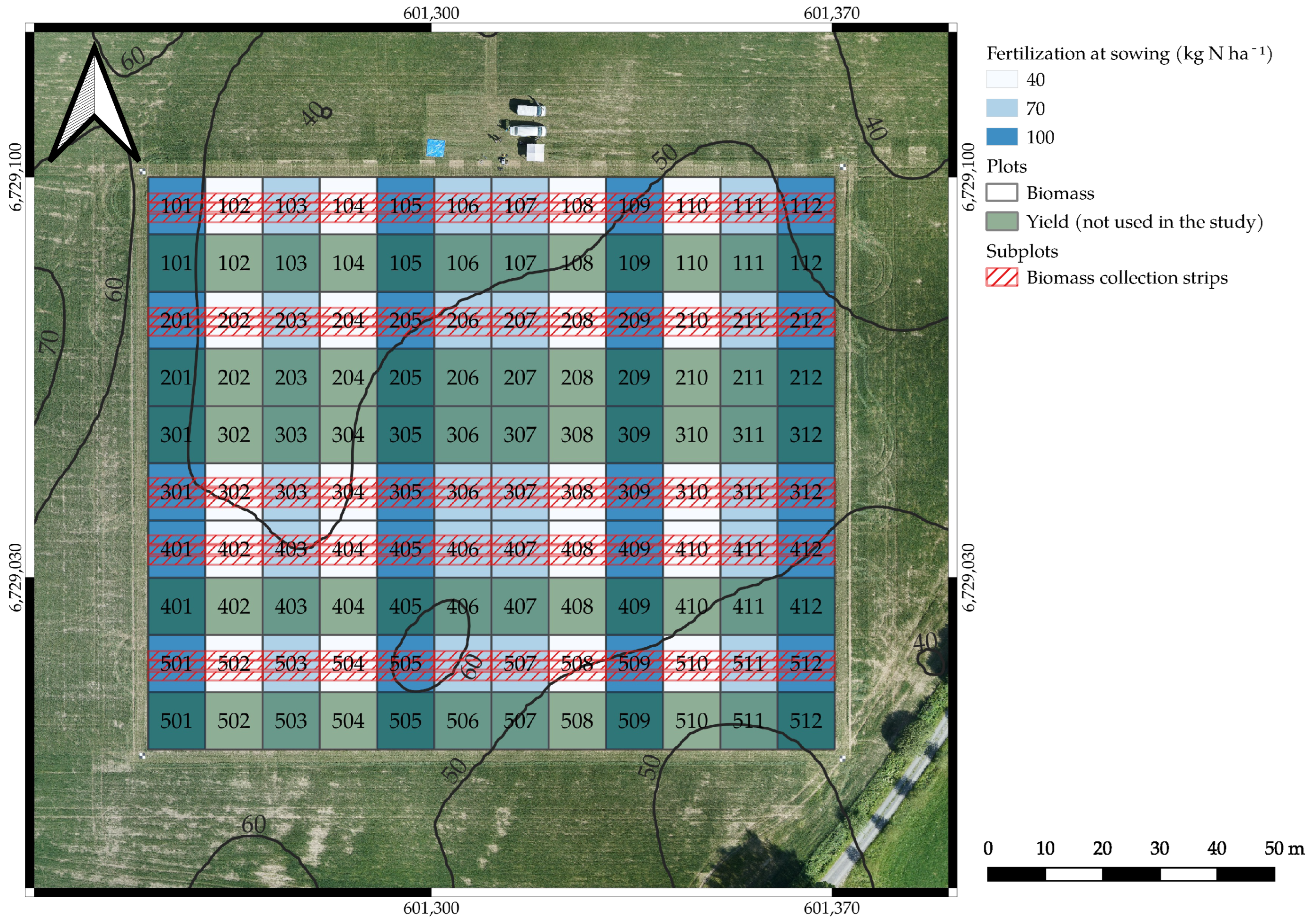
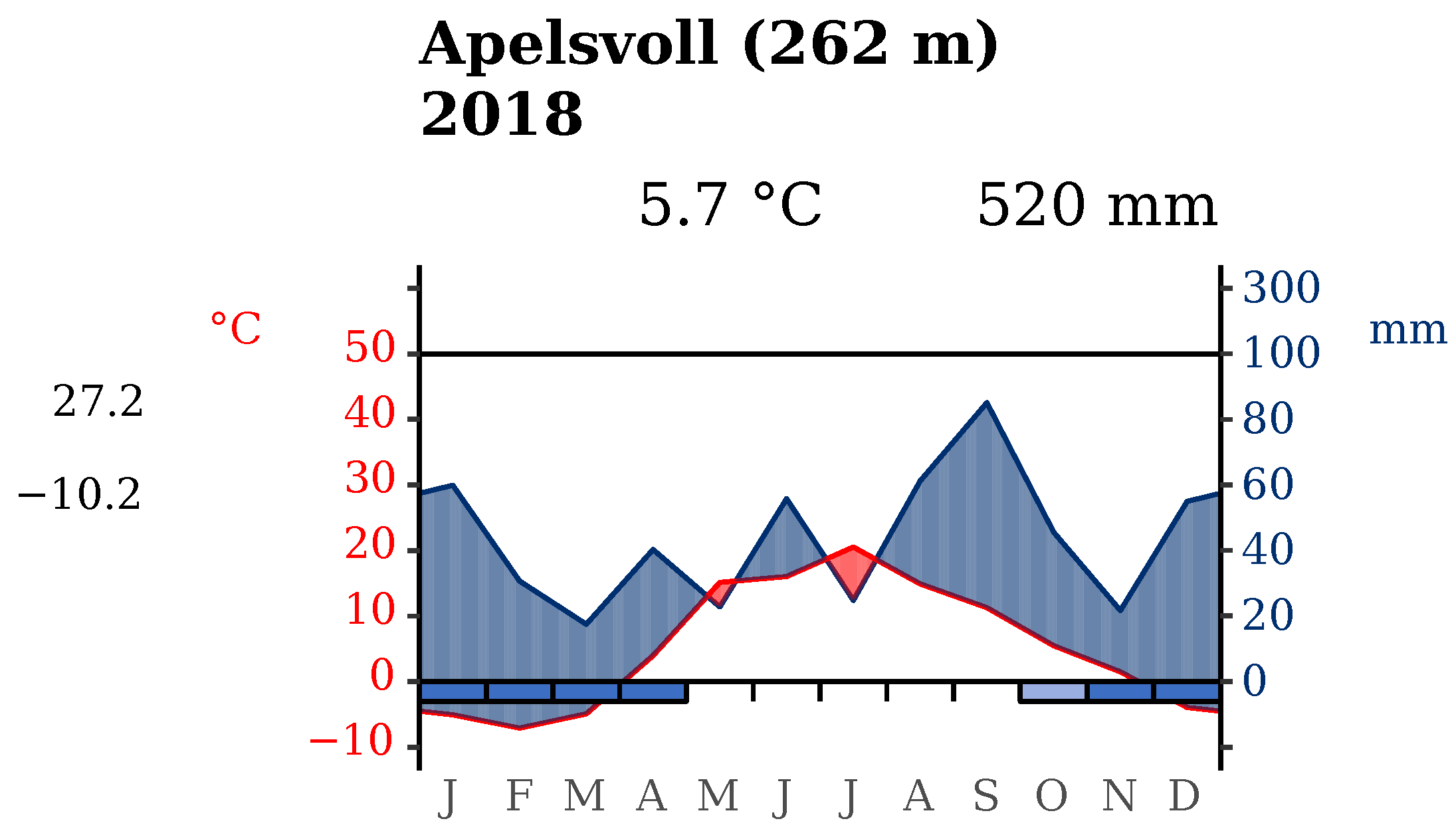
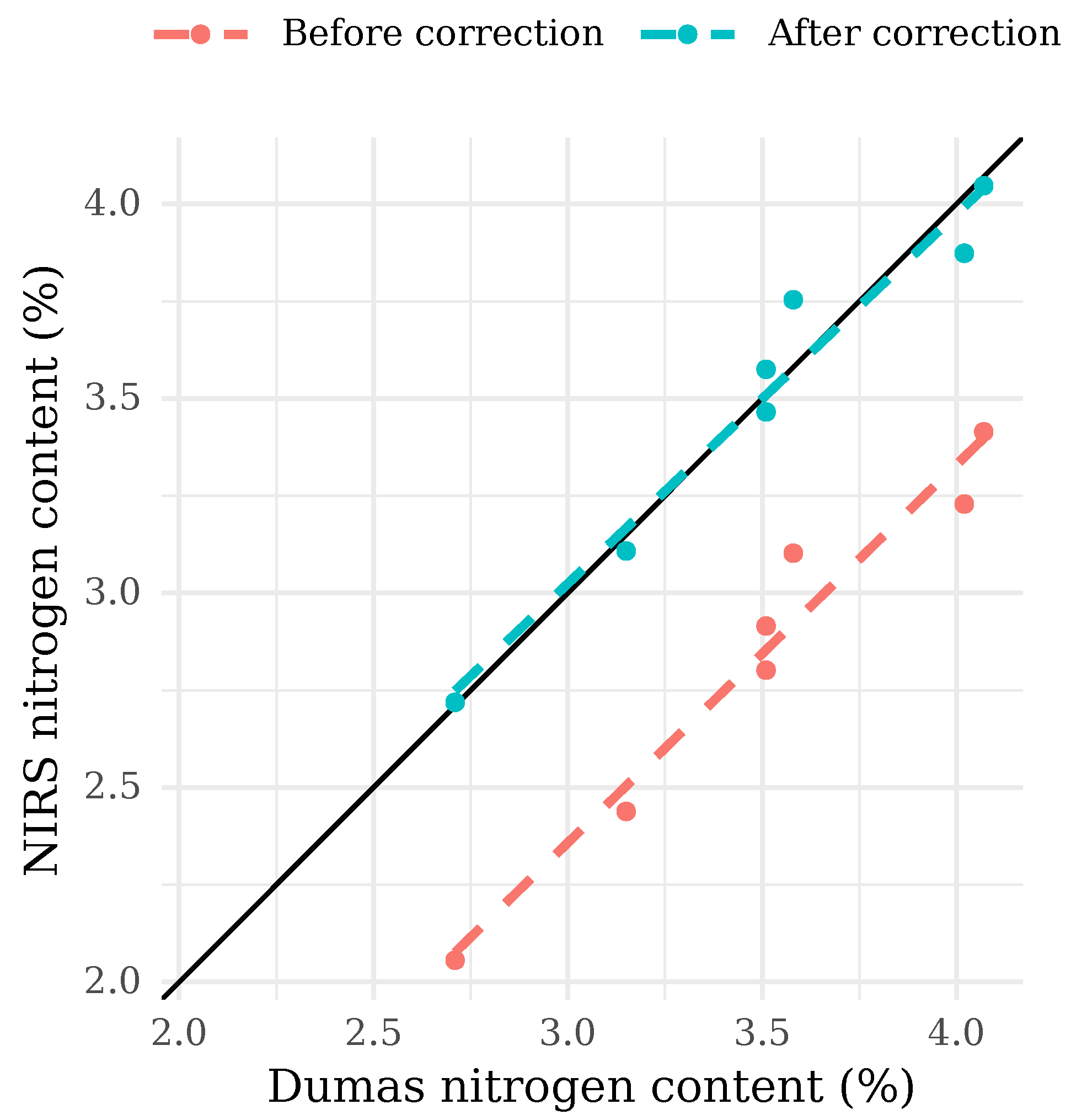
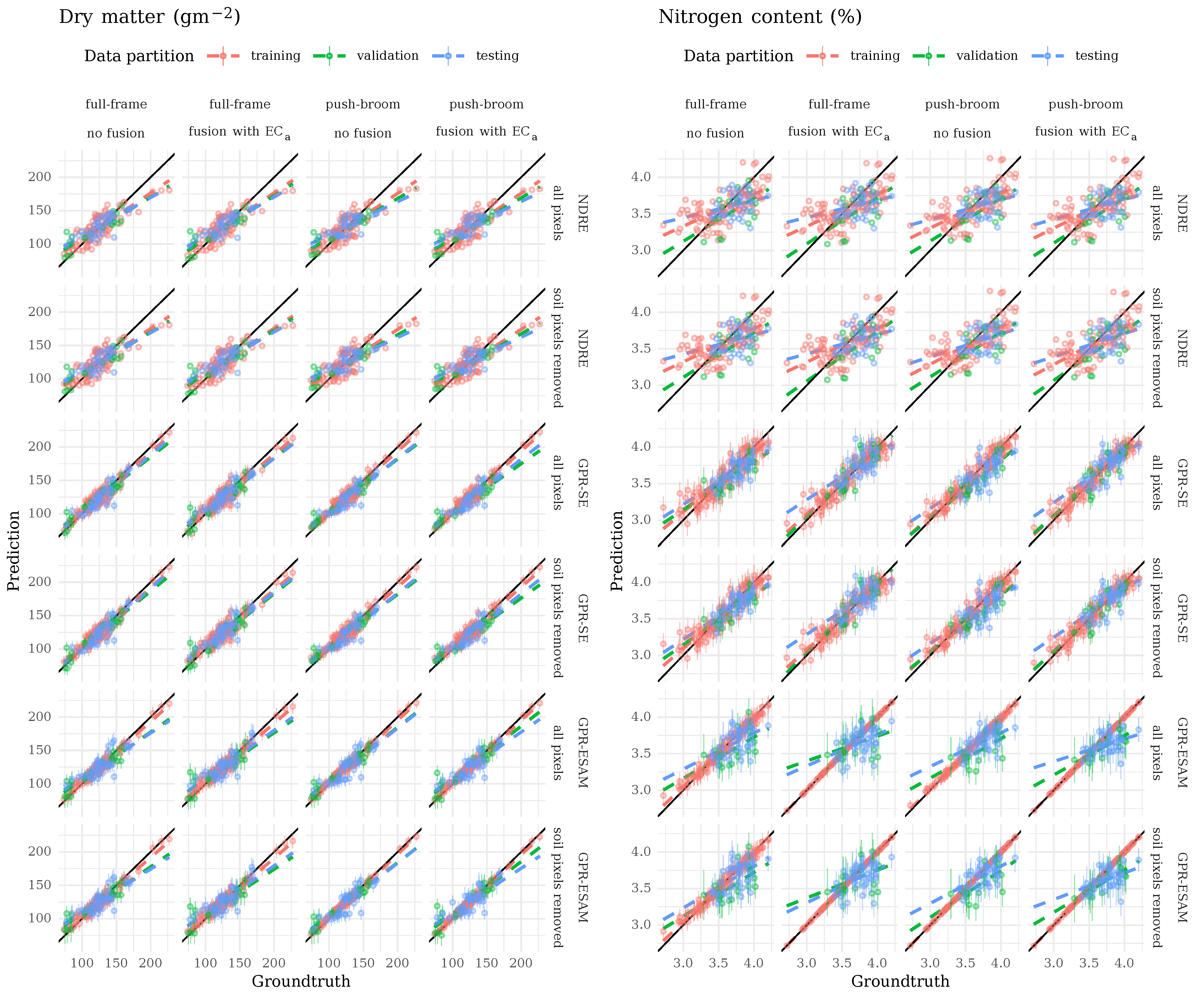
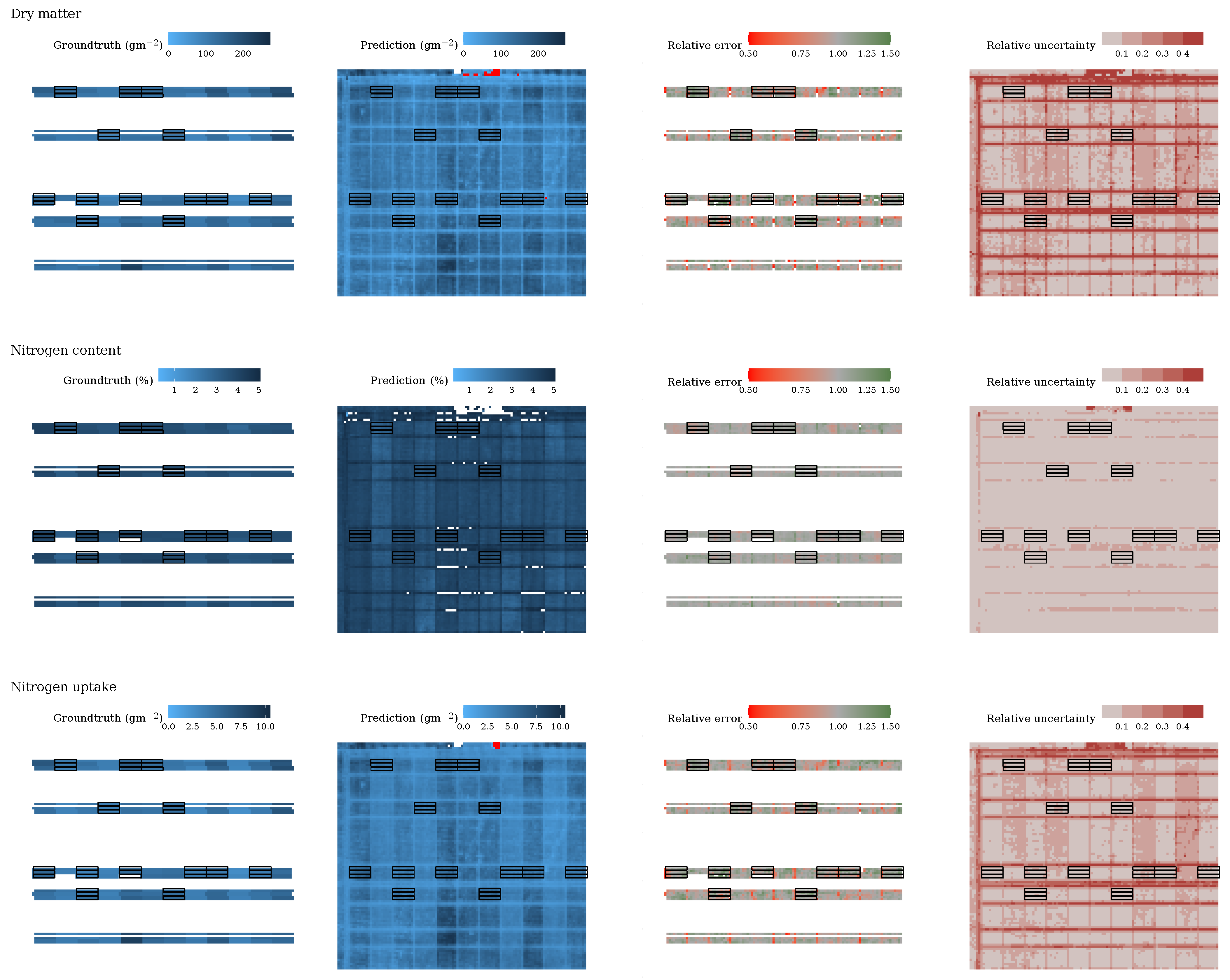
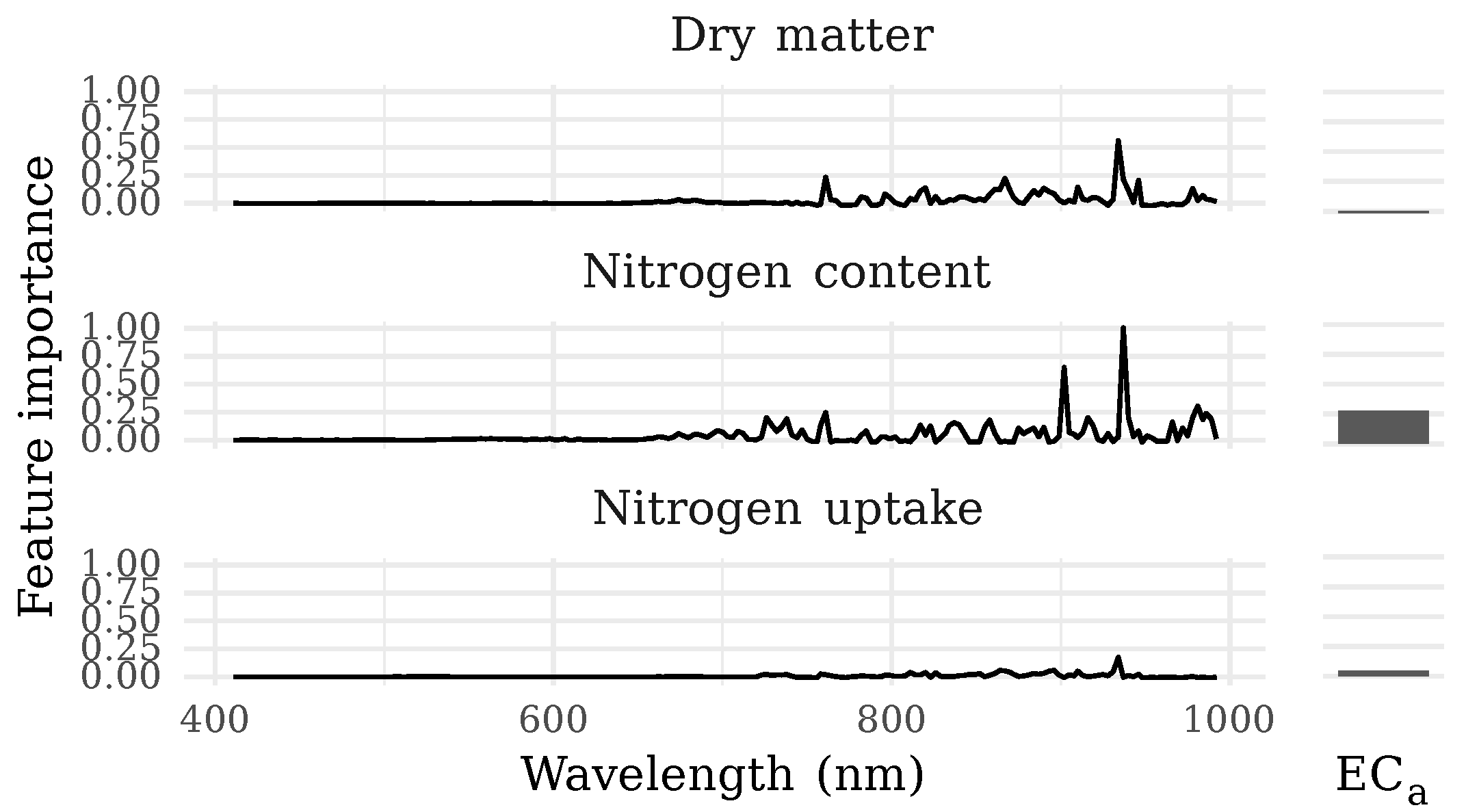
| Rikola HSI | Mjolnir V-1240 | |
|---|---|---|
| sensing type | full-frame | push-broom |
| spectral discrimination | Fabry–Pérot interferometer | dispersion grating |
| image sensor | CMOS | NA |
| field of view (°) | 36.5 | 20 |
| F-number | 2.8 | 1.8 |
| focal length () | 9 | NA |
| image dimensions () | 1010 × 1010 | 1240 |
| ground sample distance () | 4 | 4 |
| band count | 29 | 200 |
| spectral range () | 460–790 | 400–1000 |
| spectral step () | 5–20 | 3 |
| full width at half maximum () | 9.85–19.35 | 2 |
| radiometric resolution () | 12 | 12 |
| Partitioning Imager | Modeling Imager | Spectra | Spectra, Soil Pixels Removed | Spectra + | Spectra + , Soil Pixels Removed | ||||||||||||
|---|---|---|---|---|---|---|---|---|---|---|---|---|---|---|---|---|---|
| R2 | Bias | RMSEP | RPDp | R2 | Bias | RMSEP | RPDp | R2 | Bias | RMSEP | RPDp | R2 | Bias | RMSEP | RPDp | ||
| NDRE | |||||||||||||||||
| full-frame | full-frame | 0.62 | 0.6 | 12 | 1.64 | 0.61 | 0.3 | 13 | 1.61 | 0.63 | 0.9 | 12 | 1.68 | 0.63 | 0.7 | 12 | 1.66 |
| push-broom | 0.56 | 0.5 | 13 | 1.52 | 0.53 | 0.1 | 14 | 1.48 | 0.56 | 0.6 | 13 | 1.53 | 0.54 | 0.4 | 13 | 1.50 | |
| push-broom | full-frame | 0.52 | 4.5 | 13 | 1.47 | 0.51 | 4.2 | 13 | 1.45 | 0.54 | 4.9 | 13 | 1.49 | 0.53 | 4.7 | 13 | 1.47 |
| push-broom | 0.50 | 6.0 | 13 | 1.43 | 0.46 | 6.0 | 14 | 1.37 | 0.50 | 6.3 | 13 | 1.43 | 0.45 | 6.3 | 14 | 1.37 | |
| GPR-SE | |||||||||||||||||
| full-frame | full-frame | 0.77 | −2.3 | 10 | 2.10 | 0.76 | −2.7 | 10 | 2.05 | 0.77 | −0.5 | 10 | 2.10 | 0.76 | −0.7 | 10 | 2.06 |
| push-broom | 0.77 | −3.0 | 10 | 2.10 | 0.75 | −3.4 | 10 | 2.05 | 0.75 | −3.3 | 10 | 2.03 | 0.75 | −3.2 | 10 | 2.01 | |
| push-broom | full-frame | 0.73 | 0.4 | 10 | 1.95 | 0.74 | 0.1 | 9 | 1.99 | 0.66 | 1.0 | 11 | 1.74 | 0.63 | 0.5 | 11 | 1.67 |
| push-broom | 0.79 | 0.8 | 9 | 2.20 | 0.77 | 0.6 | 9 | 2.11 | 0.79 | 1.2 | 9 | 2.19 | 0.77 | 0.8 | 9 | 2.10 | |
| GPR-ESAM | |||||||||||||||||
| full-frame | full-frame | 0.60 | 0.0 | 13 | 1.61 | 0.63 | −0.1 | 12 | 1.67 | 0.66 | 0.4 | 12 | 1.73 | 0.64 | 0.4 | 12 | 1.69 |
| push-broom | 0.65 | −2.2 | 12 | 1.71 | 0.66 | −2.1 | 12 | 1.74 | 0.66 | −0.7 | 12 | 1.75 | 0.60 | −0.2 | 13 | 1.61 | |
| push-broom | full-frame | 0.77 | −1.6 | 9 | 2.10 | 0.73 | −1.6 | 10 | 1.94 | 0.50 | 1.7 | 13 | 1.44 | 0.48 | 1.5 | 13 | 1.40 |
| push-broom | 0.75 | 1.7 | 9 | 2.01 | 0.72 | 2.9 | 10 | 1.91 | 0.55 | 3.9 | 12 | 1.51 | 0.46 | 4.0 | 14 | 1.38 | |
| Partitioning Imager | Modeling Imager | Spectra | Spectra, Soil Pixels Removed | Spectra + | Spectra + , Soil Pixels Removed | ||||||||||||
|---|---|---|---|---|---|---|---|---|---|---|---|---|---|---|---|---|---|
| R2 | Bias | RMSEP | RPDp | R2 | Bias | RMSEP | RPDp | R2 | Bias | RMSEP | RPDp | R2 | Bias | RMSEP | RPDp | ||
| NDRE | |||||||||||||||||
| full-frame | full-frame | −0.79 | −0.13 | 0.24 | 0.76 | −0.81 | −0.13 | 0.24 | 0.75 | −0.75 | −0.12 | 0.24 | 0.77 | −0.77 | −0.12 | 0.24 | 0.76 |
| push-broom | −0.64 | −0.13 | 0.23 | 0.79 | −0.63 | −0.13 | 0.23 | 0.79 | −0.60 | −0.12 | 0.23 | 0.80 | −0.57 | −0.12 | 0.22 | 0.81 | |
| push-broom | full-frame | −0.07 | −0.15 | 0.25 | 0.98 | −0.07 | −0.15 | 0.25 | 0.98 | −0.06 | −0.15 | 0.25 | 0.99 | −0.06 | −0.15 | 0.25 | 0.98 |
| push-broom | 0.04 | −0.13 | 0.24 | 1.03 | 0.07 | −0.13 | 0.23 | 1.05 | 0.04 | −0.13 | 0.24 | 1.04 | 0.08 | −0.13 | 0.23 | 1.06 | |
| GPR-SE | |||||||||||||||||
| full-frame | full-frame | 0.40 | −0.07 | 0.14 | 1.31 | 0.50 | −0.06 | 0.13 | 1.44 | 0.35 | 0.00 | 0.14 | 1.26 | 0.36 | 0.02 | 0.14 | 1.26 |
| push-broom | −0.08 | −0.11 | 0.19 | 0.97 | −0.10 | −0.11 | 0.19 | 0.97 | 0.38 | −0.01 | 0.14 | 1.29 | 0.37 | −0.01 | 0.14 | 1.28 | |
| push-broom | full-frame | 0.66 | −0.05 | 0.14 | 1.75 | 0.68 | −0.05 | 0.14 | 1.79 | 0.72 | −0.03 | 0.13 | 1.91 | 0.70 | −0.02 | 0.13 | 1.84 |
| push-broom | 0.69 | −0.06 | 0.13 | 1.83 | 0.67 | −0.06 | 0.14 | 1.78 | 0.83 | −0.02 | 0.10 | 2.45 | 0.82 | −0.02 | 0.10 | 2.41 | |
| GPR-ESAM | |||||||||||||||||
| full-frame | full-frame | −0.20 | −0.09 | 0.20 | 0.92 | −0.19 | −0.09 | 0.20 | 0.93 | −0.27 | −0.10 | 0.20 | 0.90 | −0.30 | −0.10 | 0.20 | 0.89 |
| push-broom | 0.11 | −0.08 | 0.17 | 1.07 | 0.19 | −0.07 | 0.16 | 1.13 | −0.37 | −0.13 | 0.21 | 0.87 | −0.36 | −0.13 | 0.21 | 0.87 | |
| push-broom | full-frame | 0.44 | −0.08 | 0.18 | 1.36 | 0.48 | −0.07 | 0.17 | 1.41 | 0.58 | −0.08 | 0.16 | 1.57 | 0.59 | −0.09 | 0.15 | 1.58 |
| push-broom | 0.61 | −0.08 | 0.15 | 1.62 | 0.65 | −0.08 | 0.14 | 1.72 | 0.35 | −0.11 | 0.19 | 1.25 | 0.39 | −0.10 | 0.19 | 1.30 | |
| Partitioning Imager | Modeling Imager | Spectra | Spectra, Soil Pixels Removed | Spectra + | Spectra + , Soil Pixels Removed | ||||||||||||
|---|---|---|---|---|---|---|---|---|---|---|---|---|---|---|---|---|---|
| R2 | Bias | RMSEP | RPDp | R2 | Bias | RMSEP | RPDp | R2 | Bias | RMSEP | RPDp | R2 | Bias | RMSEP | RPDp | ||
| NDRE | |||||||||||||||||
| full-frame | full-frame | 0.69 | −0.11 | 0.43 | 1.81 | 0.67 | −0.12 | 0.44 | 1.77 | 0.72 | −0.09 | 0.41 | 1.90 | 0.71 | −0.10 | 0.42 | 1.88 |
| push-broom | 0.66 | −0.11 | 0.45 | 1.75 | 0.64 | −0.12 | 0.47 | 1.69 | 0.68 | −0.10 | 0.44 | 1.79 | 0.67 | −0.11 | 0.45 | 1.76 | |
| push-broom | full-frame | 0.76 | 0.00 | 0.39 | 2.07 | 0.75 | −0.01 | 0.40 | 2.02 | 0.78 | 0.02 | 0.38 | 2.16 | 0.77 | 0.01 | 0.39 | 2.10 |
| push-broom | 0.80 | 0.08 | 0.36 | 2.25 | 0.77 | 0.08 | 0.39 | 2.11 | 0.80 | 0.09 | 0.36 | 2.27 | 0.77 | 0.09 | 0.38 | 2.11 | |
| GPR-SE | |||||||||||||||||
| full-frame | full-frame | 0.81 | −0.15 | 0.34 | 2.32 | 0.81 | −0.15 | 0.34 | 2.32 | 0.87 | −0.06 | 0.28 | 2.78 | 0.86 | −0.06 | 0.29 | 2.72 |
| push-broom | 0.76 | −0.20 | 0.38 | 2.06 | 0.75 | −0.21 | 0.39 | 2.04 | 0.83 | −0.12 | 0.32 | 2.47 | 0.83 | −0.13 | 0.32 | 2.46 | |
| push-broom | full-frame | 0.82 | −0.03 | 0.34 | 2.42 | 0.83 | −0.04 | 0.33 | 2.44 | 0.83 | −0.01 | 0.33 | 2.47 | 0.83 | −0.02 | 0.33 | 2.43 |
| push-broom | 0.84 | −0.05 | 0.32 | 2.57 | 0.84 | −0.05 | 0.33 | 2.50 | 0.87 | 0.02 | 0.29 | 2.77 | 0.86 | 0.02 | 0.30 | 2.70 | |
| GPR-ESAM | |||||||||||||||||
| full-frame | full-frame | 0.66 | −0.11 | 0.45 | 1.74 | 0.68 | −0.11 | 0.44 | 1.79 | 0.74 | −0.13 | 0.39 | 2.00 | 0.74 | −0.13 | 0.40 | 1.98 |
| push-broom | 0.67 | −0.18 | 0.44 | 1.77 | 0.67 | −0.17 | 0.45 | 1.76 | 0.70 | −0.20 | 0.43 | 1.84 | 0.69 | −0.17 | 0.43 | 1.81 | |
| push-broom | full-frame | 0.74 | −0.13 | 0.40 | 2.00 | 0.74 | −0.15 | 0.40 | 2.01 | 0.68 | −0.08 | 0.45 | 1.80 | 0.68 | −0.08 | 0.46 | 1.78 |
| push-broom | 0.81 | −0.04 | 0.35 | 2.33 | 0.80 | 0.01 | 0.36 | 2.28 | 0.73 | 0.01 | 0.41 | 1.96 | 0.69 | 0.02 | 0.44 | 1.83 | |
| NDVI Threshold | Dry Matter () | Nitrogen Content () | Nitrogen Uptake () | |||||||||
|---|---|---|---|---|---|---|---|---|---|---|---|---|
| R2 | Bias | RMSEP | RPDp | R2 | Bias | RMSEP | RPDp | R2 | Bias | RMSEP | RPDp | |
| No segmentation | 0.79 | 1.2 | 8.6 | 2.19 | 0.83 | −0.020 | 0.10 | 2.45 | 0.87 | 0.020 | 0.29 | 2.77 |
| 0.30 | 0.78 | 1.0 | 8.6 | 2.19 | 0.83 | −0.020 | 0.10 | 2.44 | 0.87 | 0.020 | 0.29 | 2.76 |
| 0.35 | 0.78 | 0.8 | 8.6 | 2.18 | 0.83 | −0.020 | 0.10 | 2.43 | 0.86 | 0.020 | 0.29 | 2.76 |
| 0.40 | 0.78 | 0.8 | 8.7 | 2.16 | 0.83 | −0.020 | 0.10 | 2.42 | 0.86 | 0.020 | 0.30 | 2.75 |
| 0.45 | 0.77 | 0.8 | 8.8 | 2.13 | 0.82 | −0.020 | 0.10 | 2.41 | 0.86 | 0.020 | 0.30 | 2.73 |
| 0.50 | 0.77 | 0.8 | 8.9 | 2.10 | 0.82 | -0.020 | 0.10 | 2.41 | 0.86 | 0.020 | 0.30 | 2.70 |
Publisher’s Note: MDPI stays neutral with regard to jurisdictional claims in published maps and institutional affiliations. |
© 2022 by the authors. Licensee MDPI, Basel, Switzerland. This article is an open access article distributed under the terms and conditions of the Creative Commons Attribution (CC BY) license (https://creativecommons.org/licenses/by/4.0/).
Share and Cite
Żelazny, W.R.; Kusnierek, K.; Geipel, J. Gaussian Process Modeling of In-Season Physiological Parameters of Spring Wheat Based on Airborne Imagery from Two Hyperspectral Cameras and Apparent Soil Electrical Conductivity. Remote Sens. 2022, 14, 5977. https://doi.org/10.3390/rs14235977
Żelazny WR, Kusnierek K, Geipel J. Gaussian Process Modeling of In-Season Physiological Parameters of Spring Wheat Based on Airborne Imagery from Two Hyperspectral Cameras and Apparent Soil Electrical Conductivity. Remote Sensing. 2022; 14(23):5977. https://doi.org/10.3390/rs14235977
Chicago/Turabian StyleŻelazny, Wiktor R., Krzysztof Kusnierek, and Jakob Geipel. 2022. "Gaussian Process Modeling of In-Season Physiological Parameters of Spring Wheat Based on Airborne Imagery from Two Hyperspectral Cameras and Apparent Soil Electrical Conductivity" Remote Sensing 14, no. 23: 5977. https://doi.org/10.3390/rs14235977
APA StyleŻelazny, W. R., Kusnierek, K., & Geipel, J. (2022). Gaussian Process Modeling of In-Season Physiological Parameters of Spring Wheat Based on Airborne Imagery from Two Hyperspectral Cameras and Apparent Soil Electrical Conductivity. Remote Sensing, 14(23), 5977. https://doi.org/10.3390/rs14235977










